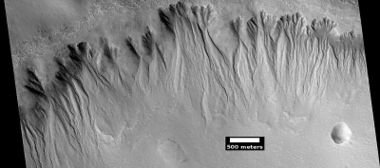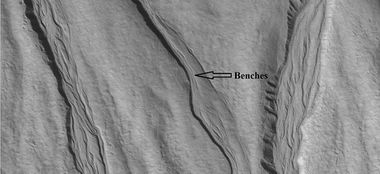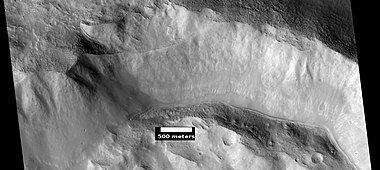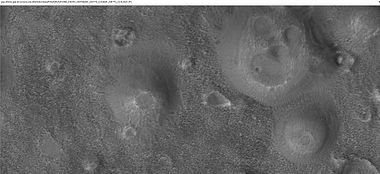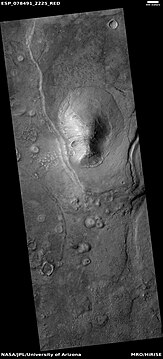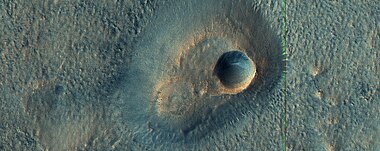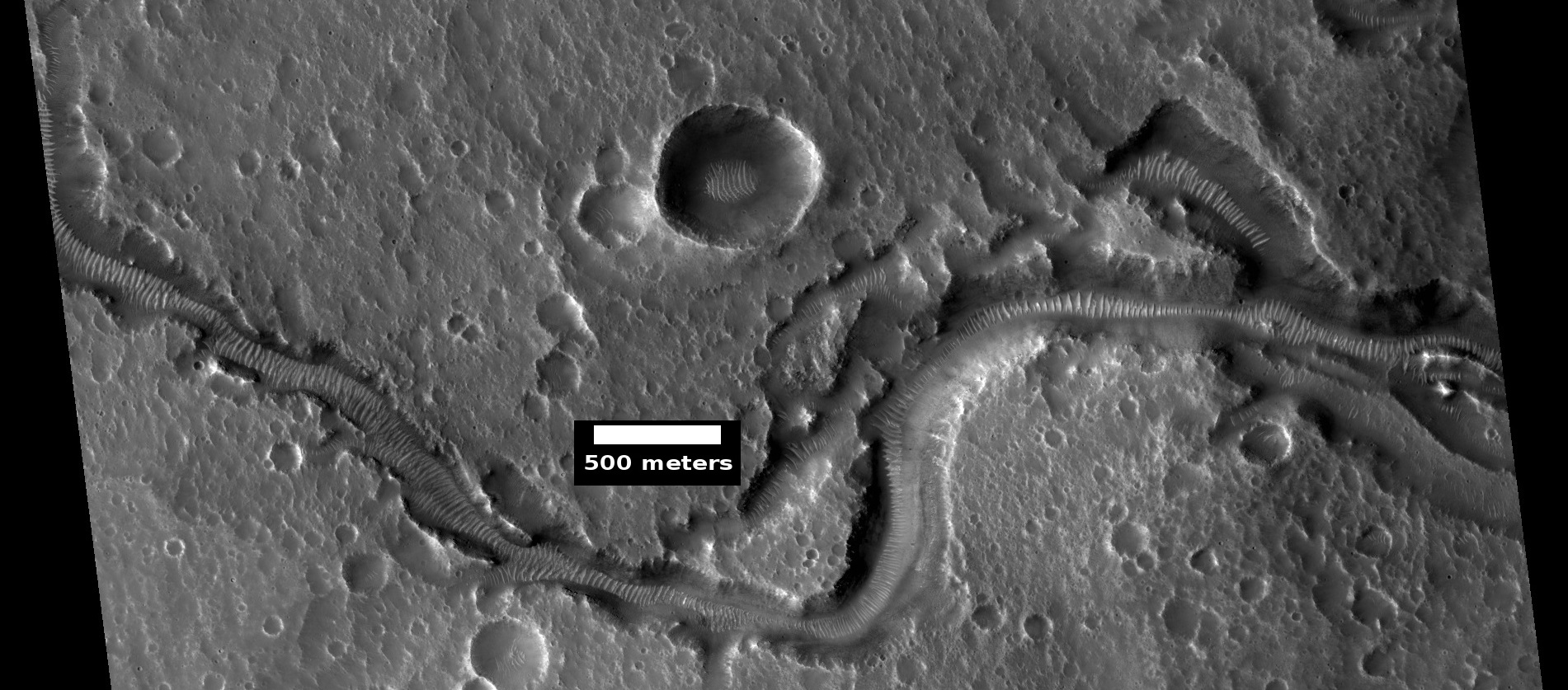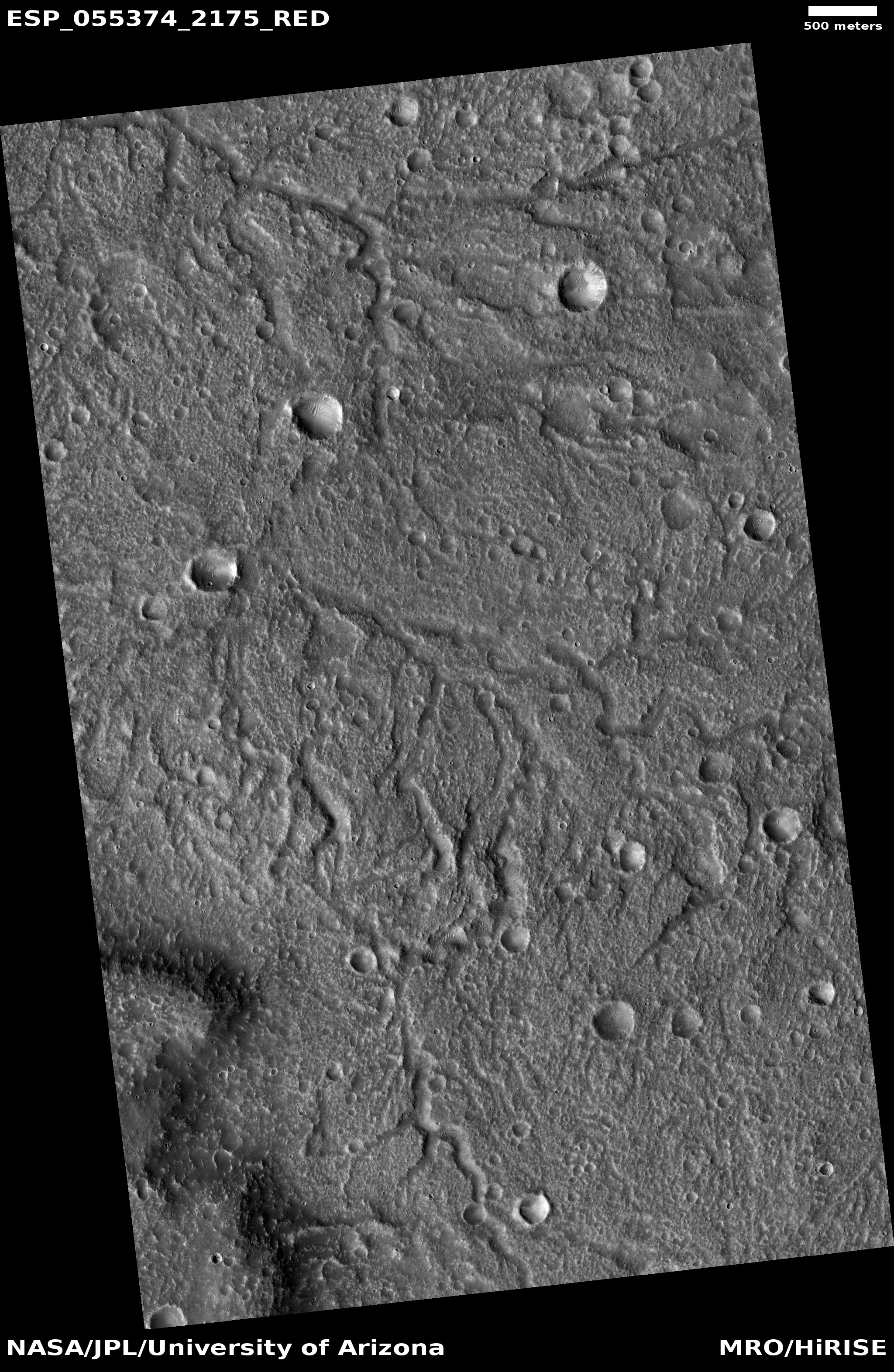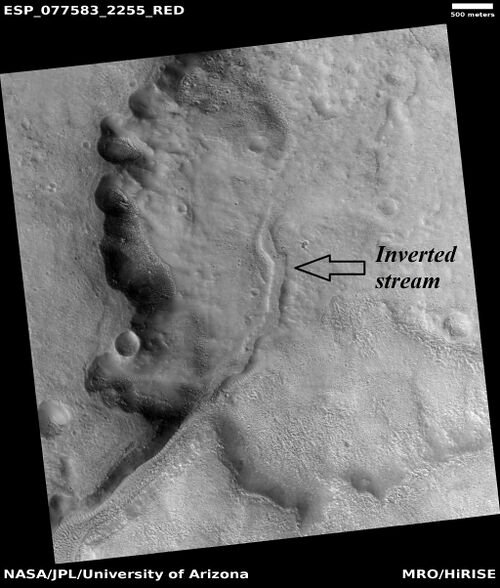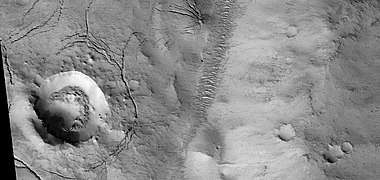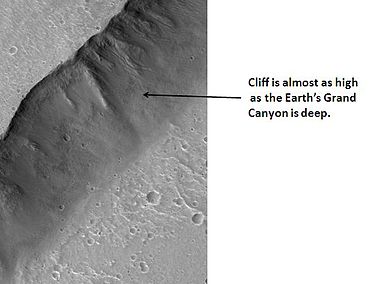Difference between revisions of "Mare Acidalium quadrangle"
Suitupshowup (talk | contribs) (→Channels: added image of channels) |
Suitupshowup (talk | contribs) m (→Mud volcanoes) |
||
| (4 intermediate revisions by the same user not shown) | |||
| Line 65: | Line 65: | ||
File:55122 2225gulliesclosecolor.jpg|Gullies, as seen by HiRISE under [[HiWish program]] | File:55122 2225gulliesclosecolor.jpg|Gullies, as seen by HiRISE under [[HiWish program]] | ||
| + | |||
| + | File:Close view of gullies ESP 080430 2310 01.jpg|Gullies on crater wall The bright apron is a bit unusual. | ||
| + | File:Close view of gullies ESP 080430 2310 02.jpg|Gully on crater wall The bright apron is a bit unusual. | ||
| + | |||
</gallery> | </gallery> | ||
| Line 129: | Line 133: | ||
ESP 052050 2200mudvolcanoes.jpg|Wide view of field of mud volcanoes | ESP 052050 2200mudvolcanoes.jpg|Wide view of field of mud volcanoes | ||
| + | File:84807 2225conecolor 01.jpg|Close view of mud volcano, as seen by HiRISE. Picture is about 1 km across. This mud volcano has a different color than the surroundings because it consists of material brought up from depth. These structures may be useful to explore for reamins of past life since they contain samples that would have been protected from the strong radiation at the surface. | ||
</gallery> | </gallery> | ||
| Line 162: | Line 167: | ||
File:Labeled meander showing early and later channels ESP 59515 2160.jpg|Meander with parts labeled Features like this show that water stayed around for a while. Meanmders start with small loops that get progressively larger. | File:Labeled meander showing early and later channels ESP 59515 2160.jpg|Meander with parts labeled Features like this show that water stayed around for a while. Meanmders start with small loops that get progressively larger. | ||
| + | |||
| + | File:6438 2155meander.jpg | ||
| + | |||
</gallery> | </gallery> | ||
| Line 261: | Line 269: | ||
48924 2150ovalpits.jpg|Sample of oval pits in this location of unknown origin, as seen by HiRISE under HiWish program | 48924 2150ovalpits.jpg|Sample of oval pits in this location of unknown origin, as seen by HiRISE under HiWish program | ||
| + | File:Fan along crater wall. ESP 055110 2265.jpg|Fan This fan is formed on the edge of a crater. Dirt and rocks mixed with water, flowed down a slope and were deposited in crater. The fan has layers which means that this was done at different intervals, not all at once. This image was named picture of the day for January 14, 2024. Image credit is NASA/JPL/University of Arizona/Secosky. | ||
</gallery> | </gallery> | ||
Latest revision as of 11:03, 7 October 2024
| MC-04 | Mare Acidalium | 30–65° N | 0–60° W | Quadrangles | Atlas |
The face on Mars is found in the lower right corner or the Mare Acidalium quadrangle, between the craters Aranda and Bamberg in the Cydonia Labyrinthus region.
The Mare Acidalium quadrangle contains many interesting features, but is most famous for an eroded mesa that looked like a face when originally seen in Viking images in the 70’s. Outstanding views of polygonal ground, mud volcanoes, gullies, and channels are here. In this article, some of the best pictures from a number of spacecraft will show what the landscape looks like in this region. The origins and significance of all features will be explained as they are currently understood.
The Mare Acidalium quadrangle is one of a series of 30 quadrangle maps of Mars used by the United States Geological Survey (USGS). The quadrangle is located in the northern hemisphere and covers 30° to 65° north latitude and 0° to 60° west longitude (300° to 360° east longitude). The Mare Acidalium quadrangle is also referred to as MC-4 (Mars Chart-4).[1] The southern and northern borders of the quadrangle are approximately 3,065 km and 1,500 km wide, respectively. The north to south distance is about 2,050 km (slightly less than the length of Greenland).[2] The quadrangle covers a little over 3% of Mars’ surface.
Many regions with classical names are located here. Most of the region called Acidalia Planitia is found in Acidalium quadrangle. Parts of Tempe Terra, Arabia Terra, and Chryse Planitia are also in this quadrangle. This area contains many bright spots on a dark background that may be mud volcanoes. Lomonosov Crater and Kunowsky Crater are easily seen. The famous "face" on Mars is located in the Cydonia Mensae area--the southeastern part of quadrangle.
In this article, some of the best pictures from a number of spacecraft will show what the landscape looks like in this region. The origins and significance of all features will be explained as they are currently understood.
The quadrangle contains many interesting features, including gullies and possible shorelines of an ancient northern ocean. Some areas are densely layered. The boundary between the southern highlands and the northern lowlands lies in Mare Acidalium.[3] The Cydonia Region includes the Face on Mars (located near 40.8 degrees north and 9.6 degrees west). When Mars Global Surveyor examined it with high resolution, the face turned out to just be an eroded mesa.[4] Mare Acidalium contains the Kasei Valles system of canyons. This huge system is 300 miles wide in some places—Earth's Grand Canyon is only 18 miles wide.[5]
Contents
Origin of name
Mare Acidalium (Acidalian Sea) is the name of a classical albedo features on Mars located at 45° N and 330° E on Mars. The feature was named for a well or fountain in Boeotia, Greece. According to classical tradition, it is a location where Venus and the Graces bathed.[6] The name was approved by the International Astronomical Union (IAU) in 1958.[7]
Gullies
Acidalia Colles Gullies and other features, as seen by HiRISE The scale bar is 1,000 meters long.
The HiRISE image above of Acidalia Colles shows gullies in the northern hemisphere. Gullies occur on steep slopes, especially craters. Gullies are believed to be relatively young because they have few, if any craters, and they lie on top of sand dunes which are themselves young. Usually, each gully has an alcove, channel, and apron. Many researchers believed that the processes carving the gullies involved liquid water. However, with more observations and research this idea was changed.
As soon as gullies were discovered, researchers began to image many gullies over and over, looking for possible changes. By 2006, some changes were found.[8] Later, with further analysis it was determined that the changes could have occurred with dry granular flows rather than being driven by flowing water.[9] [10] [11] With continued observations many more changes were found in Gasa Crater and other craters.[12]
With more repeated observations, more and more changes were found; since the changes occur in the winter and spring, experts are tending to believe that gullies were formed from dry ice. Before-and-after images demonstrated the timing of this activity coincided with seasonal carbon-dioxide frost changes, and at temperatures that would not have allowed for liquid water. The conditions during gully formation are just about right to allow chunks of dry ice to slide down slopes. In addition, when dry ice frost changes to a gas, it may lubricate dry material to flow especially on steep slopes.[13] [14][15] In some years frost build up may be-as thick as 1 meter.
Context for next image of Bamberg crater. Box shows where the next image came from. This is a CTX image from Mars Reconnaissance Orbiter.
Gullies and massive flow of material, as seen by HiRISE under HiWish program. Gullies are enlarged in next two images.
Gullies, as seen by HiRISE under HiWish program
Polygonal patterned ground
Close-up of gully alcove showing "gullygons" (polygonal patterned ground near gullies), as seen by HiRISE
Polygonal, patterned ground is quite common in some regions of Mars.[16] [17] [18] [19] [20] [21] [22] It is commonly believed that the shapes we see here are related to ground frozen with water ice.
Craters
Impact craters generally have a rim with ejecta around them, in contrast volcanic craters usually do not have a rim or ejecta deposits.[23] Sometimes craters display layers. Since the collision that produces a crater is like a powerful explosion, rocks from deep underground are tossed unto the surface. Hence, craters can show us what lies deep under the surface.
Exhumed Crater in Mare Acidalium, as seen by Mars Global Surveyor This crater was buried and now it is being uncovered.
Crater with pits on floor, as seen by HiRISE under HiWish program
Mud volcanoes
Line of possible mud volcanoes
Large areas of Mare Acidalium display bright spots on a dark background. It has been suggested that these spots are mud volcanoes.[24] [25][26] More than 18,000 of these features, which have an average diameter of about 800 meters, have been mapped.[27] As more observations poured in over the years, more evidence supported the notion that these abundant bright marks are mud volcanoes. Mare Acidalium would have received large quantities of mud and fluids form outflow channels, so much mud may have accumulated there. The bright mounds have been found to contain crystalline ferric oxides. Mud volcanism may be highly significant because long lived conduits for upwelling groundwater could have been produced. These could have been habitats for micro organisms.[28] Mud volcanoes could have brought up samples from deep zones that could be gathered by robots.[29] The authors of an article in Icarus compare these Martian features to mud volcanoes found on the Earth. Their study using HiRISE images and CRISM data support the idea that these features are indeed mud volcanoes. Nanophase ferric minerals and hydrated minerals found with Compact Reconnaissance Imaging Spectrometer for Mars (CRISM) show that water was involved with the formation of these possible Martian mud volcanoes.[30] Scientists are excited that Mars may have mud volcanoes because these small volcanoes may have brought up samples of dirt that were not affected by the high radiation on the Martian surface. We may find evidence of past life in these volcanoes.
Craters with white centers in Mare Acidalium. Sand dunes are visible in low areas in image. Some of the features may be mud volcanoes. Picture taken by Mars Global Surveyor under the MOC Public Targeting Program.
- Mottled terrain ESP 080653 2255.jpg
Mottled terrain that consists of mud volcanoes
Possible mud volcano, as seen by HiRISE under HiWish program
Close view of mud volcano, as seen by HiRISE. Picture is about 1 km across. This mud volcano has a different color than the surroundings because it consists of material brought up from depth. These structures may be useful to explore for reamins of past life since they contain samples that would have been protected from the strong radiation at the surface.
Channels in Idaeus Fossae region
There is a 300 km long ancient river system in Idaeus Fossae. It is carved into the highlands of Idaeus Fossae, and it originated from the melting of ice in the ground after asteroid impacts. There is evidence that it was formed relatively recently. Dating has determined that the water activity came after most of the water activity ended at the boundary between the Noachian and Hesperian periods. Lakes and fan-shaped deposits were formed by running water in this system as it drained eastward into Liberta Crater and formed a delta deposit. Part of the drainage path is the Moa Valley.[31] [32]
Channels
Channels
There is much evidence that water once flowed in river valleys on Mars.[33] [34] Images of curved channels have been seen in images from Mars spacecraft dating back to the early seventies with the Mariner 9 orbiter.[35] [36] [37] [38] We have seen more and more channels with each orbiter mission to the Red Planet. Indeed, a study published in June 2017, calculated that the volume of water needed to carve all the channels on Mars was even larger than the proposed ocean that the planet may have had.[39][40]
Channel network
Ocean
Many researchers have suggested that Mars once had a great ocean in the north.[41] [42] [43] [44] [45] [46] [47] Much evidence for this ocean has been gathered over several decades. New evidence was published in May 2016. A large team of scientists described how some of the surface in Ismenius Lacus quadrangle was altered by two tsunamis. The tsunamis were caused by asteroids striking into an ocean. Both were thought to have been strong enough to create 30 km diameter craters. The first tsunami picked up and carried boulders the size of cars or small houses. The backwash from the wave formed channels by rearranging the boulders. The second came in when the ocean was 300 m lower. The second carried a great deal of ice which was dropped in valleys. Calculations show that the average height of the waves would have been 50 m, but the heights would vary from 10 m to 120 m. So, some large waves would have gone over a 36 story building.[48] Asteroids hitting an ocean on Mars are quite possible. Numerical simulations show that in this particular part of the ocean two 30 km in diameter would form every 30 million years. The implication here is that a great northern ocean may have existed for millions of years. One argument against an ocean has been the lack of shoreline features. But shoreline features may have been washed away by these tsunami events. The parts of Mars studied in this research are Chryse Planitia and northwestern Arabia Terra. These tsunamis affected some surfaces in the Ismenius Lacus quadrangle and in the Mare Acidalium quadrangle.[49] [50] [51] [52]
Pingos
Pingos are believed to be present on Mars. They are mounds that contain cracks. These particular fractures were evidently produced by something emerging from below the brittle surface of Mars. Ice lenses, resulting from the accumulation of ice beneath the surface, possibly created these mounds with fractures. Ice is less dense than rock, so the buried ice rose and pushed upwards on the surface and generated these cracks. An analogous process creates similar sized mounds in arctic tundra on Earth. The name pingos is an Inuit word.[53] They contain pure water ice, so they would be a great source of water for future colonists on Mars.
Arrows point to possible pingos, as seen by HiRISE under HiWish program Pingos contain a core of pure ice.
Fractured ground
Close view of cracks on crater floor, as seen by HiRISE under HiWish program
Cracks around crater, as seen by HiRISE under HiWish program
Layers
Layered terrain is common on the Earth and on Mars. Water is usually involved with the formation of layers. Hence, when we see layers, there is the possibility of a lake or sea in the past.
Layers in mesa, as seen by HiRISE under HiWish program
Rock can be formed into layers in a variety of ways. Volcanoes, wind, or water can produce layers[54] Layers can be hardened by the action of groundwater. Martian ground water probably moved hundreds of kilometers, and in the process it dissolved many minerals from the rock it passed through. When ground water surfaces in low areas containing sediments, water evaporates in the thin atmosphere and leaves behind minerals as deposits and/or cementing agents.
Features close to Face on Mars
Here are some CTX images of area near the Face. These pictures show natural formations on Mars. In the area around the face are mesas, mud volcanoes, pedestal craters, and brain terrain. Many of the mesas are sitting on what looks like platforms. They may be from a change in sea level. There is strong evidence building that an ocean was once all through the northern lowlands. All of the features seen here are common on Mars, especially in this latitude. For more pictures and information about the face go to The The Face on Mars.
Terrain near Face showing possible glacier erosion Curved portions of the mounds look like the start of what are called cirques that form as snow accumulates on mountains.[55]
Mesa, ridges, possible cirques near Face.
Other landscape features in Mare Acidalium quadrangle
Boulders that are about 2.2 yards across (smaller than a bedroom) and their tracks after rolling down a cliff in Kasei Valles system, as seen by HiRISE
Close-up of a possible fault in Mare Acidalium, as seen by HiRISE under the HiWish program. A circle is drawn around crater to show that it may be off round because of movement of the fault. Many other faults are in the region.
Fan This fan is formed on the edge of a crater. Dirt and rocks mixed with water, flowed down a slope and were deposited in crater. The fan has layers which means that this was done at different intervals, not all at once. This image was named picture of the day for January 14, 2024. Image credit is NASA/JPL/University of Arizona/Secosky.
See also
- The Face on Mars
- High Resolution Imaging Science Experiment (HiRISE)
- HiWish program
- How are features on Mars Named?
References
- ↑ Davies, M.E.; Batson, R.M.; Wu, S.S.C. "Geodesy and Cartography" in Kieffer, H.H.; Jakosky, B.M.; Snyder, C.W.; Matthews, M.S., Eds. Mars. University of Arizona Press: Tucson, 1992.
- ↑ Distances calculated using NASA World Wind measuring tool. http://worldwind.arc.nasa.gov/.
- ↑ http://hirise.lpl.arizona.edu/PSP_010354_2165
- ↑ http://mars.jpl.nasa.gov/mgs/msss/camera/images/moc_5_24_01/face/index.html
- ↑ http://hiroc.lpl.arizona.edu/images/PSP/diafotizo.php?ID=PSP_001640_2125
- ↑ Blunck, J. 1982. Mars and its Satellites. Exposition Press. Smithtown, N.Y.
- ↑ USGS Gazetteer of Planetary Nomenclature. Mars. http://planetarynames.wr.usgs.gov/.
- ↑ Malin, M., K. Edgett, L. Posiolova, S. McColley, E. Dobrea. 2006. Present-day impact cratering rate and contemporary gully activity on Mars. Science 314, 1573_1577.
- ↑ Kolb, et al. 2010. Investigating gully flow emplacement mechanisms using apex slopes. Icarus 2008, 132-142.
- ↑ McEwen, A. et al. 2007. A closer look at water-related geological activity on Mars. Science 317, 1706-1708.
- ↑ Pelletier, J., et al. 2008. Recent bright gully deposits on Mars wet or dry flow? Geology 36, 211-214.
- ↑ NASA/Jet Propulsion Laboratory. "NASA orbiter finds new gully channel on Mars." ScienceDaily. ScienceDaily, 22 March 2014. www.sciencedaily.com/releases/2014/03/140322094409.htm
- ↑ http://www.jpl.nasa.gov/news/news.php?release=2014-226
- ↑ http://hirise.lpl.arizona.edu/ESP_032078_1420
- ↑ http://www.space.com/26534-mars-gullies-dry-ice.html
- ↑ http://www.diss.fu-berlin.de/diss/servlets/MCRFileNodeServlet/FUDISS_derivate_000000003198/16_ColdClimateLandforms-13-utopia.pdf?hosts=
- ↑ Kostama, V.-P., M. Kreslavsky, Head, J. 2006. Recent high-latitude icy mantle in the northern plains of Mars: Characteristics and ages of emplacement. Geophys. Res. Lett. 33 (L11201). doi:10.1029/2006GL025946.
- ↑ Malin, M., Edgett, K. 2001. Mars Global Surveyor Mars Orbiter Camera: Interplanetary cruise through primary mission. J. Geophys. Res. 106 (E10), 23429–23540.
- ↑ Milliken, R., et al. 2003. Viscous flow features on the surface of Mars: Observations from high-resolution Mars Orbiter Camera (MOC) images. J. Geophys. Res. 108 (E6). doi:10.1029/2002JE002005.
- ↑ Mangold | first1 = N | year = 2005 | title = High latitude patterned grounds on Mars: Classification, distribution and climatic control | url = | journal = Icarus | volume = 174 | issue = | pages = 336–359 | doi = 10.1016/j.icarus.2004.07.030 |
- ↑ Kreslavsky, M., Head, J. 2000. Kilometer-scale roughness on Mars: Results from MOLA data analysis. J. Geophys. Res. 105 (E11), 26695–26712.
- ↑ Seibert | first1 = N. | last2 = Kargel | first2 = J. | year = 2001 | title = Small-scale martian polygonal terrain: Implications for liquid surface water | url = | journal = Geophys. Res. Lett. | volume = 28 | issue = 5| pages = 899–902 | doi = 10.1029/2000gl012093 |
- ↑ Hugh H. Kieffer|title=Mars|url=https://books.google.com/books?id=NoDvAAAAMAAJ%7Caccessdate=7 March 2011|year=1992|publisher=University of Arizona Press|isbn=978-0-8165-1257-7
- ↑ Farrand | first1 = W. | display-authors = etal | year = 2005 | title = Pitted cones and domes on Mars: observations in Acidalia Planitia and Cydonia Mensae using MOC, THEMIS, and TES data | url = | journal = J. Geophys. Res. | volume = 110 | issue = | page = 14 | doi = 10.1029/2004JE002297
- ↑ Tanaka, K. et al. 2003 Resurfacing history of the northern plains of Mars based on geologic mapping of Mars Global Surveyor data. J. Geophys. Res. 108 (E4), doi:10.1029/2002JE001908.
- ↑ Grotzinger, J. and R. Milliken (eds.) 2012. Sedimentary Geology of Mars. SEPM
- ↑ Oehler, D. and C. Allen. 2010. Evidence for pervasive mud volcanism in Acidalia Planitia, Mars. Icarus: 208. 636-657.
- ↑ Komatsu, G., et al. 2014. ASTROBIOLOGICAL POTENTIAL OF MUD VOLCANISM ON MARS. 45th Lunar and Planetary Science Conference (2014). 1085.pdf
- ↑ Oehler | first1 = D | last2 = Allen | first2 = C. | year = 2011 | title = Evidence for pervasive mud volcanism in Acidalia Planitia, Mars | url = | journal = Icarus | volume = 208 | issue = | pages = 636–657 | doi = 10.1016/j.icarus.2010.03.031 }}
- ↑ Komatsu, G., et al. 2016. Small edifice features in Chryse Planitia, Mars: Assessment of a mud volcano hypothesis. Icarus: 268, 56-75.
- ↑ Salese, F., G. Di Achille, F., et al. 2016. Hydrological and sedimentary analyses of well-preserved paleo fluvial-paleolacustrine systems at Moa Valles, Mars. J. Geophys. Res. Planets. 121, 194–232, doi:10.1002/2015JE004891.
- ↑ Salese, F., G. Di Achille, G. Ori. 2015. SEDIMENTOLOGY OF A RIVER SYSTEM WITH A SERIES OF DAM-BREACH PALEOLAKES AT IDAEUS FOSSAE, MARS. 46th Lunar and Planetary Science Conference 2296.pdf
- ↑ Baker | first1 = V. | display-authors = etal | year = 2015 | title = Fluvial geomorphology on Earth-like planetary surfaces: a review | journal = Geomorphology | volume = 245 | issue = | pages = 149–182 |
- ↑ Carr, M. 1996. in Water on Mars. Oxford Univ. Press.
- ↑ Baker, V. 1982. The Channels of Mars. Univ. of Tex. Press, Austin, TX
- ↑ Baker | first1 = V. | last2 = Strom | first2 = R. | last3 = Gulick | first3 = V. | last4 = Kargel | first4 = J. | last5 = Komatsu | first5 = G. | last6 = Kale | first6 = V. | year = 1991 | title = Ancient oceans, ice sheets and the hydrological cycle on Mars | url = | journal = Nature | volume = 352 | issue = | pages = 589–594 | doi = 10.1038/352589a0 |
- ↑ Carr | first1 = M | year = 1979 | title = Formation of Martian flood features by release of water from confined aquifers | url = | journal = J. Geophys. Res. | volume = 84 | issue = | pages = 2995–300 | doi = 10.1029/jb084ib06p02995 |
- ↑ Komar | first1 = P | year = 1979 | title = Comparisons of the hydraulics of water flows in Martian outflow channels with flows of similar scale on Earth | url = | journal = Icarus | volume = 37 | issue = | pages = 156–181 | doi = 10.1016/0019-1035(79)90123-4 |
- ↑ http://spaceref.com/mars/how-much-water-was-needed-to-carve-valleys-on-mars.html
- ↑ Luo, W., et al. 2017. New Martian valley network volume estimate consistent with ancient ocean and warm and wet climate. Nature Communications 8. Article number: 15766 (2017). doi:10.1038/ncomms15766
- ↑ Parker | first1 = T. J. | last2 = Gorsline | first2 = D. S. | last3 = Saunders | first3 = R. S. | last4 = Pieri | first4 = D. C. | last5 = Schneeberger | first5 = D. M. | year = 1993 | title = Coastal geomorphology of the Martian northern plains | url = | journal = J. Geophys. Res. | volume = 98 | issue = E6| pages = 11061–11078 | doi=10.1029/93je00618 |
- ↑ Fairén | first1 = A. G. |display-authors=etal | year = 2003 | title = Episodic flood inundations of the northern plains of Mars | url = http://eprints.ucm.es/10431/1/9-Marte_3.pdf%7C journal = Icarus | volume = 165 | issue = 1| pages = 53–67 |
- ↑ Head | first1 = J. W. |display-authors=etal | year = 1999 | title = Possible ancient oceans on Mars: Evidence from Mars Orbiter Laser Altimeter data | url = | journal = Science | volume = 286 | issue = 5447| pages = 2134–2137 | doi=10.1126/science.286.5447.2134| pmid = 10591640 |
- ↑ Parker, T. J., Saunders, R. S. & Schneeberger, D. M. Transitional morphology in west Deuteronilus Mensae, Mars: Implications for modification of the lowland/upland boundary" Icarus 1989; 82, 111–145
- ↑ Carr | first1 = M. H. | last2 = Head | first2 = J. W. | year = 2003 | title = Oceans on Mars: An assessment of the observational evidence and possible fate | url = | journal = J. Geophys. Res. | volume = 108 | issue = E5| page = 5042 |
- ↑ Kreslavsky | first1 = M. A. | last2 = Head | first2 = J. W. | year = 2002| title = Fate of outflow channel effluent in the northern lowlands of Mars: The Vastitas Borealis Formation as a sublimation residue from frozen ponded bodies of water | url = | journal = J. Geophys. Res. | volume = 107 | issue = E12| page = 5121 |
- ↑ Clifford, S. M. & Parker, T. J. The evolution of the martian hydrosphere: Implications for the fate of a primordial ocean and the current state of the northern plains" Icarus 2001; 154, 40–79
- ↑ https://www.convertunits.com/from/metre/to/story
- ↑ Ancient Tsunami Evidence on Mars Reveals Life Potential |date=May 20, 2016 |url=http://astrobiology.com/2016/05/ancient-tsunami-evidence-on-mars-reveals-life-potential.html
- ↑ Rodriguez | first1 = J. |display-authors=etal | year = 2016 | title = Tsunami waves extensively resurfaced the shorelines of an early Martian ocean | url = | journal = Scientific Reports | volume = 6 | issue = | page = 25106 | doi=10.1038/srep25106| pmid = 27196957 | pmc = 4872529 |
- ↑ | doi=10.1038/srep25106| pmid=27196957| pmc=4872529| title=Tsunami waves extensively resurfaced the shorelines of an early Martian ocean| journal=Scientific Reports| volume=6| pages=25106| year=2016| last1=Rodriguez| first1=J. Alexis P.| last2=Fairén| first2=Alberto G.| last3=Tanaka| first3=Kenneth L.| last4=Zarroca| first4=Mario| last5=Linares| first5=Rogelio| last6=Platz| first6=Thomas| last7=Komatsu| first7=Goro| last8=Miyamoto| first8=Hideaki| last9=Kargel| first9=Jeffrey S.| last10=Yan| first10=Jianguo| last11=Gulick| first11=Virginia| last12=Higuchi| first12=Kana| last13=Baker| first13=Victor R.| last14=Glines| first14=Natalie
- ↑ Cornell University. "Ancient tsunami evidence on Mars reveals life potential." ScienceDaily. ScienceDaily, 19 May 2016. https://www.sciencedaily.com/releases/2016/05/160519101756.htm.
- ↑ http://www.uahirise.org/ESP_046359_1250
- ↑ http://hirise.lpl.arizona.edu?PSP_008437_1750
- ↑ http://www.landforms.eu/cairngorms/corrie%20formation.htm







